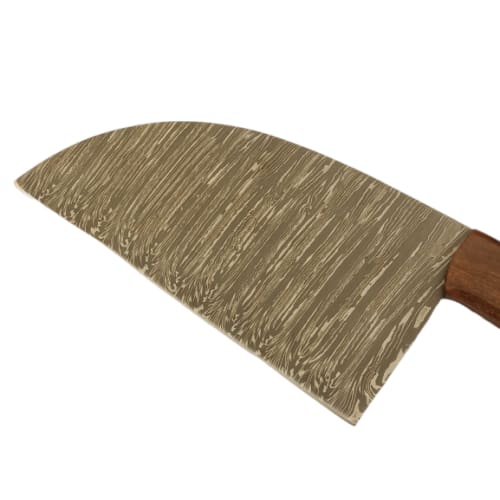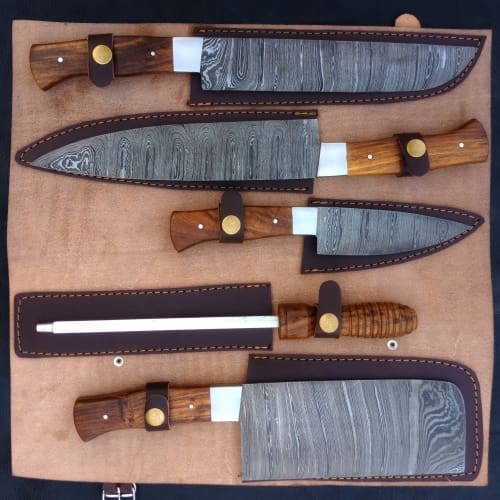Damascus steel has a lengthy history, and customers are drawn in by its distinctive appearance. What precisely is it, though, and how does it compare to other types of steel?
1. Knowing Your Materials

Since I've already written an article on the history of Damascus steel, I won't go into depth about it here. Instead, click here to read the article: History of Damascus steel.
For a number of reasons, this kind of steel is highly regarded. It produces some of the most exquisite knives, axes and swords you'll ever see. Because it's so eye-catching, it has gradually grown to be associated with gastronomic luxury. It's a great tool to have it in your kitchen.
By exploring the world of Damascus steel, we may hopefully dispel some popular misconceptions about them. What is Damascus steel? Where does it come from? What’s it supposed to look like? Is it as good as people say?
2. What Is Damascus Steel?

History of Damascus Steel
So let’s take it straight from the source. As the name implies, Damascus steel comes from the city of Damascus, where over a thousand years ago the local blacksmiths were considered to be some of the finest in the world. This was due to their unique techniques of steel fabrication, their methods creating some of the most gorgeous swords in the entire world.
There’s that word you’re going to find a few times throughout this article: “gorgeous.” The truth is, a lot of the hoopla over Damascus steel blades comes down to how they look. And the origins of this lie with these blacksmiths: The way they made these swords utilized a complex process that involved heating and folding the steel unto itself many times, creating a stronger and more ductile blade.
Impressive Style & Durability
Not only did you end up with an impressive blade performance, but you also ended up with an impressive blade look. The result of all this heating and folding onto itself was an intricate “swirl” unique pattern, reminiscent of waves crashing over a beach. So these blades were extremely appealing to look at as well as feature a spectacular performance, holding an edge for much longer than was standard at the time. They were also able to withstand usage that would result in other blades getting chipped and damaged quite easily.
But, is all of this actually true? As with many things in history, it’s hard to know. The original techniques have been washed away with the ages, devolving into legend and hearsay. But, as we know, legend often comes with a kernel of truth. Regardless of the absolute, objective veracity of these claims, what remains undeniable is that Damascus blades developed a reputation for their stunning look and impressive performance.
Advancements in Damascus Steel
Of course, humans have gotten much better at metallurgy with time. There have been advancements that resulted in steel types that were considerably stronger than what you might have found in Damascus over a thousand years ago. It’s hard to imagine that the blades of old Damascus could realistically stand up to the kind of blades we routinely produce today. So as far as performance is concerned, Damascus steel is something we’ve handily outdone by this point.
The appearance of Damascus steel still carries a tremendous amount of allure, and it’s something that we continue to be drawn to after all these years. If there’s something humans can become enamored with, it’s nifty-looking stuff.
Modern Day Blacksmiths Are Improving Damascus Steel
So how do modern-day blacksmiths achieve the Damascus steel look while still maximizing steel performance? Well, the answer is simple: they mix and match. Sometimes they use a process called pattern welding.
You see, most high-end Japanese knives these days are made by putting together layers of different types of steel. Usually, there is a thin layer of hard, brittle steel in the core – this is your cutting core. Then this cutting core is laminated between two layers of softer steel, which not only acts as a shock absorber but also as the outward-facing portion of the blade. This is what is known as the cladding. These days, you’re most likely to find modern Damascus steel as the cladding of Damascus steel knives, not as the core.
So these days Damascus steel knives are either forge-welded from different types of steel which can then be manipulated into a pattern, or they’re made from high-end stainless steel blades melted together in a crucible; the stainless Damascus result is still absolutely gorgeous to see, whether it’s on a small blade like a paring knife, a medium blade like a chef knife, or a long blade-like a slicing or carving knife.
3. Benefits of Damascus Steel Knives

So now that we know the truth behind Damascus steel knives – that these days you’re much more likely to find a knife that uses Damascus steel as the cladding over a different steel cutting core – let’s talk about the primary benefits of owning Damascus steel knives.
The first and most obvious one might make us seem vain, but it’s aesthetics. If there’s something every consumer of any kind of high-end home product knows, it's that driving urge to own stuff that looks cool, that says something about who you are and what you like, that externalizes your sense of identity into a tangible object. If kitchen knives aren’t a great example of that, I don’t know what is.
If you can find a Damascus steel knife that is made from layers of high-carbon steel with an inner core of high-carbon specialty steel, you’ve struck gold. Not only will you get an absolutely beautiful blade but you’re also guaranteed a high-performing kitchen tool. Looks and performance work together in perfect harmony.
When we talk about high-quality materials, of course, that is usually accompanied by a larger price tag. If you’re looking for something that looks and feels and handles well, you need to be prepared to pay a little bit more. And whether that extra cost is justified or not is entirely a personal choice – I know many people who would argue passionately for either side of that particular argument.
But remember: “Damascus” does not automatically mean better. Not every Damascus knife is going to be right for you. If you use your knife extensively, you care about its looks, and you want something that handles great and stays sharp, then I say go for it.
4. Cleaning your Damascus knife
Taking care of a Damascus steel blade is similar to taking care of a carbon steel blade. You need to make sure that moisture stays as far away from it as possible. When you clean it, rinse clean under running water and then wipe it dry with a clean cloth.
Make sure you never leave the blade resting in standing water. Also, avoid letting the blade rest on a damp washcloth or tea towel, or cloth of any kind. If you can avoid storing it in direct contact with leather, good. And don’t wash it in a dishwasher. Moisture is the enemy and the more you can keep it away from your Damascus steel knife, the better.
Sharpening your Damascus knife
Thankfully, sharpening a Damascus knife is as easy to do as sharpening a stainless steel or high carbon steel knife. There are a few different ways to do this. The classics are:
Whetstones. We’re big fans of using Whetstones to sharpen your kitchen knives, and though it may seem a little intimidating to a newbie, it’s pretty straightforward – check out our explainer on how to sharpen a knife with a whetstone. All you have to do is hold your knife by the handle and angle its blade towards the stone until you achieve the correct precision.
Manual sharpeners are a more affordable, less intimidating solution. These usually come with slots for the different types of sharpening, and it’s as easy as running your blade through each slot a few times before putting it away.
Honing rods are a pretty common tool in the kitchen, and there’s a widely held misconception that they are for sharpening. As their name implies, honing steel rods are for honing, which means to reposition and align the edge of the blade. You should have no problems using this with a Damascus steel knife.
Overall, the same tools and processes you know and love from sharpening other kitchen knives will be available to you when you’re using a Damascus kitchen knife.

